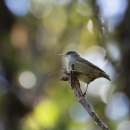Saving Kauaʻi Forest Birds - Final Environmental Assessment of Using Incompatible Insect Technique for Mosquito Suppression
Project Summary
Hawaiʻi’s native forest bird species have undergone precipitous declines and extinctions since the arrival of humans to the archipelago, particularly Europeans; 39 of the 56 native Hawaiian honeycreepers have gone extinct and 11 of the remaining 17 species are endangered or threatened. Although several factors have led to declines of these remaining species, the main threat to Hawaiian honeycreepers is currently avian malaria (Plasmodium relictum) and avian pox (Avipoxvirus spp.); nonnative diseases that are principally spread by the nonnative southern house mosquito (Culex quinquefasciatus). Until recently, there were no viable means available to control mosquito vectors at the landscape scale within natural areas in Hawaiʻi.
The Incompatible Insect Technique (IIT) has been successfully implemented in 14 countries worldwide to control mosquitoes that carry human diseases, including four cities in the United States. The technique uses lab-raised male mosquitoes carrying a select strain of Wolbachia, a bacterium that naturally occurs in at least 65% of insect species. When male mosquitoes, which do not bite or transmit diseases, are released into a target habitat and mate with wild female mosquitoes that either contain different or no strains of Wolbachia, the eggs fail to develop owing to the cytoplasmic incompatibility of the differing Wolbachia strains of the male and female mosquitoes. The development of IIT for mosquito-borne diseases that affect humans presents a unique opportunity to use this tool to control mosquitoes that spread avian diseases to native forest bird species in Hawaiʻi. This approach does not employ genetic engineering and does not involve or result in the genetic modification of either mosquitoes or bacteria.
The State of Hawaiʻi Department of Land and Natural Resources (DLNR) and U.S. Fish and Wildlife Service (USFWS) proposes employing IIT to reduce mosquito populations within approximately 59,204 acres (23,959 hectares) of forest reserves, state parks, and private lands in the Kōkeʻe and Alakaʻi Wilderness areas of Kauaʻi to protect birds from mosquito-borne diseases in key higher-elevation native forest bird habitat. This effort is consistent with the statutory missions and responsibilities of the DLNR and USFWS. The multi-stakeholder project would raise and sequentially mass-release male mosquitoes that carry a strain of Wolbachia that is incompatible with natal females. Extensive pre- and post-release monitoring would be implemented to monitor the effectiveness of releasing incompatible male mosquitoes on the wild mosquito populations. A similar unconnected project has been proposed for implementation by the National Park Service and DLNR on the island of Maui[1]. To comply with their respective obligations under the National Environmental Policy Act (NEPA) and Hawaiʻi’s environmental review process pursuant to Hawaiʻi Revised Statutes (HRS) Chapter 343, the USFWS and DLNR are preparing a joint environmental assessment (EA) to address the impacts of the release of male mosquitoes with incompatible Wolbachia in the Kōkeʻe and Alakaʻi Wilderness areas. This EA provides background information concerning IIT and outlines the proposed action, potential impacts, and strategies to avoid and minimize potential negative effects of the proposed release of incompatible male mosquitoes within the project area on Kauaʻi.
Learn more about:
Final Environmental Assessment
The draft EA was released on June 23, 2023, for a 31-day commenting period that concluded on July 24, 2023. On July 11, 2023, the Service, DLNR, and their partners, held an open house on Kauaʻi to dialogue with members of the community, receive public comments, and answer questions.
A finding of no significant impact (FONSI) was issued on September 22, 2023, to conclude the NEPA process and document the decision of the final EA. A FONSI is issued when environmental analysis and interagency review during the EA process find a project to have no significant impacts on the quality of the environment. The statements and conclusions reached in this FONSI are based on documentation and analysis provided in the final EA.
Although the EA was a cooperative federal and state compliance document satisfying both NEPA and the Hawai‘i Environmental Policy Act (HEPA) regulations, this FONSI analyzes only the impacts under current NEPA standards.
The FONSI and final EA directly support the U.S. Department of the Interior’s Strategy for Preventing the Extinction of Hawaiian Forest Birds.
To read the FONSI, CLICK HERE.
To read the Final EA, CLICK HERE.
To read the Final EA and FONSI News Release, CLICK HERE.
Frequently Asked Questions
Q: What do mosquitoes have to do with the native birds of Hawaiʻi?
A: Twenty-three species of honeycreepers have gone extinct in Hawaiʻi since the first arrival of mosquitoes in the early 1800s, with many extinctions linked to avian malaria and pox. Most of Hawai‘i’s remaining native honeycreepers are now found only at high elevations where it is too cold for the southern house mosquitoes and the avian malaria parasite.
The native forest birds evolved away from the presence of disease, so they have little to no immune response to bird diseases. For the ʻiʻiwi, after one bite from an infected mosquito, there is a 90% chance it will die. As our climate warms, mosquitoes are moving to higher elevations, and the available habitat for our native forest birds is disappearing.
Q: How does the Incompatible Insect Technique work?
A: The Incompatible Insect Technique (IIT) is a way to control insect pests, like mosquitoes, without using harmful chemicals. In Hawaiʻi, this technique involves releasing male mosquitoes that carry a different, incompatible strain of bacteria than what is present in the wild mosquito population. When these incompatible male mosquitoes mate with the wild female mosquitoes, the resulting eggs do not hatch, decreasing the mosquito population over time.
Learn more about the Incompatible Insect Technique here.
Q: Does the Incompatible Insect Technique involve genetic modification?
A: No, the proposed technique does not modify any part of the genome of either mosquitoes or the Wolbachia bacteria.
Q: Can this have an adverse effect on the overall environment?
A: Suppressing mosquitoes should not harm the overall environment in Hawaiʻi. Our native birds, plants, and insects evolved over millions of years without mosquitoes, which were first introduced to Hawaiʻi about 200 years ago. As a result, they are not a significant part of the diets of any native species, aren't needed to pollinate native plants, and don't serve any other known ecosystem function in Hawaiʻi.
Q: How will male and female mosquitoes be sorted prior to release?
A: Mosquitoes can be separated by sex using several techniques. Males and females are different sizes at various life stages, with females being larger as pupae and adults. The first method filters out females using mechanical sieving that only allows the smaller male pupae to fall through. The second technique uses automated sorting via imaging to scan adults and separate them by physical features. For example, male mosquitoes have fuzzier antennae and smaller stomachs than female mosquitoes. Ongoing monitoring will occur for quality assurance and control in the lab and release environments.
Q: What has to happen before you release any incompatible male mosquitoes?
A: We have to comply with all state and federal regulations, including permit requirements, and ensure that the public knows about the project and has the opportunity to provide input.
Learn more about the regulatory process here.
Q: Where else has the Incompatible Insect Technique been used to control mosquitoes?
A: The method of using Wolbachia to influence mosquitoes and disease transmission has been used for decades in over ten countries worldwide, including the continental US. In most places, these techniques have targeted Aedes aegypti (yellow fever mosquito) and Aedes albopictus (Asian tiger mosquito) for public health and quality of life purposes. There have been no reports of adverse effects on human and environmental health.
Learn more about IIT implementation here.
Q: Are we introducing any new or foreign organisms to Hawaiʻi?
A: No, we are not introducing any new or foreign organisms to Hawaiʻi. The incompatible male mosquitoes reared in the lab are descendants of southern house mosquitoes initially collected in Hawaiʻi. Similarly, the strain of Wolbachia in the released male mosquitoes is also present in the bodies of another common mosquito in Hawaiʻi, the Asian tiger mosquito (Aedes albopictus).
Q: When do you plan to release the mosquitoes?
A: Small-scale pilot releases are anticipated to be conducted in 2023 - 2024. Following pilot studies, large-scale landscape releases will begin in 2024.
Update: 05/2023 - Small-scale pilot releases have begun on East Maui.
Q: Will the project happen fast enough to save our birds?
A: We don't know if it can happen fast enough to save all our birds. Based on recent field data, some of the native honeycreepers on Kauaʻi and Maui may have only two to three years before extinction. That is why this project is so urgent. We want to stop the loss of more species.
Q: Isn’t this the same as past failed “biocontrol” efforts (i.e., mongooses)?
A: This project is different from the introduction of the mongoose. The private sugarcane industry imported the mongoose to Hawaiʻi in 1883 without any regulatory oversight, approval, or community engagement. The first regulatory framework for evaluating this type of action was created in 1890 and, over time, has become increasingly rigorous. Since 1975, no biocontrol release in Hawaiʻi has caused unintended negative consequences because extensive testing and analysis are done before any release. This mosquito control project is subject to these State and Federal laws, regulations, and reviews.
Q: How do you know it's safe and won't affect other species or humans?
A: The release of Wolbachia-incompatible male mosquitoes requires rigorous testing and registration with the U.S. Environmental Protection Agency to demonstrate its safety and effectiveness. Additionally, it is considered a biological control agent, and its use must be approved by the Hawaiʻi Department of Agriculture. These public processes require the applicant to address potential environmental and human health safety issues. Moreover, this technique does not pose any known threat to humans or other species except for the targeted mosquitoes it intends to control.
Additionally, there have been no reports of adverse effects on human and environmental health where Wolbachia has been used to influence mosquito populations.
Q: What is Wolbachia?
A: Wolbachia is a naturally-occurring bacteria found in over half of all arthropod species worldwide. This includes insects, spiders, and other invertebrates such as crustaceans and nematodes. In Hawaiʻi, Wolbachia is already present in many insects, including mosquitoes such as the southern house mosquito and Asian tiger mosquito.
For many years, researchers have dedicated their efforts to examining Wolbachia to harness its potential to control mosquitoes that transmit human diseases. By incorporating these advancements in human disease control, our project strives to safeguard the native Hawaiian honeycreepers and prevent their extinction by using Wolbachia to suppress populations of the southern house mosquito.
Q: Can Wolbachia be transferred from the southern house mosquito to my loved one/pet?
A: No, Wolbachia cannot be transferred from the mosquito to you or your loved one - it can only survive in arthropod species.
The project aims only to release male incompatible mosquitoes. Male mosquitoes do not bite, which means you will not be bitten by any mosquitoes released during the project.
Additionally, you have already been bitten by mosquitoes carrying Wolbachia. The southern house mosquito and the Asian tiger mosquito both already carry Wolbachia and have carried it since they were first introduced 125-200 years ago.






